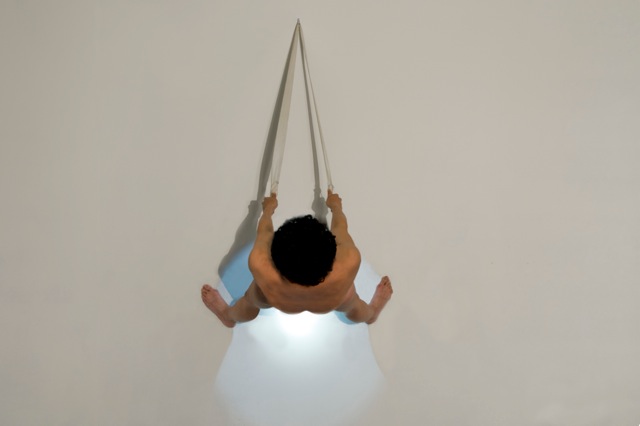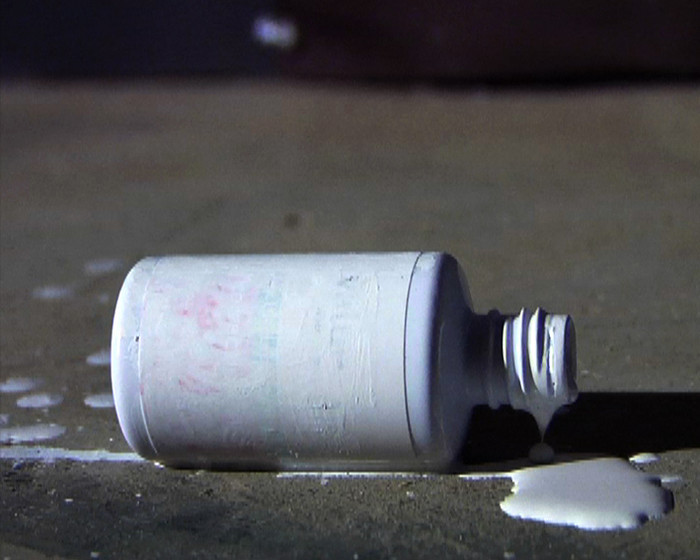NOA GUR | Body of work DEVILLE COHEN | Grayscale
11 Nov - 23 Dec 2010
Deville Cohen / Grayscale
Deville Cohen’s video work and photography describes a fantastic world where office supplies replace the components of the natural world: lids and markers hang from the trees as if they were ripe fruits, clips are collected from the ground as they were gravel or other organic materials, and photo paper builds a new space making us take another look at our familiar reality. Men in high heels, decorated with a head covering, or, alternatively scraps of printed paper depicting tractors demonstrate a fantastic relationship with mundane objects, which seeks to challenge the original meaning. The work is projected through a huge curtain made out of strips of black paper attached with clips. Inside the screening space, carpet with the same clips located in the center invites the viewer to sit and gaze.
Cohen combines elements of theater, sculpture, film and collage, which creates an image that is simultaneously simple and complex, real and imagined, familiar and strange. The video work has a narrative with three acts that situates the office supplies in the theater of absurd in gray colors, and infuses new life to these everyday objects.
Cohen’s Series of photos _L_A_C_E_, creates double meaning scenes which emphasize the gap between reality and imagination. Cohen uses different materials in different ways than intended to create a highly stylized urban landscapes. Products converge into two dimension reproductions which cuts them from their cultural significance and isolating them further from their reality.
Born in Tel Aviv, 1977. KHB Graduate, Weiseensee, Berlin (2007) and MFA Bard College (2010). Past exhibition includes: Nowhere gallery, Milan and tor111, Berlin. In 2010, Deville exhibited in Greater NY, PS1 and Lesley Heller Workspace, New York. Lives and works in New York
Noa Gur / Body of work
Noa Gur's show consists of two works: video installation and photography. In the video piece, Staircase Flesh, a gray concrete floor is projected onto the gallery's identical floor. The image slowly conveys information into the gray frame, where a reflection of water flows into a puddle drawing a visual field that is constantly changing. After a few seconds, the puddle freezes into a bright crystal, and for a brief moment, encourages the viewer to gaze at the sutured image projected: a naked body walking down metal steps in a repetitive movement, scaling down into the abyss.
Gur’s work is a reference to the work by Marcel Duchamp, “Nude Descending a Staircase (No. 2)" from 1912. The work describes a double movement that tries to link Cubism to Futurism: the way we see the human body as a whole and the way to understand an action in parts. Gur translates the relationship between time and place that exists in a painting by using the medium of video as it builds a synthetic space presenting reality and the real space present in the work.
In the projected photographic work, the artist looks as she is hanging on a hook as it desends from the ceiling. Her head turns like an arrow into the gaze of the spectator, acting as a mark on the center the screen. Her hands hold a rope tightly and her feet are against the wall with a beam of light. On the other side of the screen, a similar picture is projected with the rope hanging, but it seems from the previous motion a footprint has left hand prints, a kind of dirty body functioning as a brush, leaving a trail of black residue. Gur notes the irony of the instrumental use of the body image and challenges the perspective of reality through a distortion of editing.
Born. Tel Aviv, 1980 .Has BFA Bezalel, Jerusalem, and MFA, from KHM, Cologne. Winner of Contemporary Art Museum, Dusseldorf (2009). winner of the DAAD scholarship for academic excellence. Sharett Scholarship (2004). Exhibited worldwide includes: Dusseldorf Museum (2010), Wedaonlo Museum, Bonn, (2009), A collection Goetz Germany (2009). Lives and works in Cologne.
Deville Cohen’s video work and photography describes a fantastic world where office supplies replace the components of the natural world: lids and markers hang from the trees as if they were ripe fruits, clips are collected from the ground as they were gravel or other organic materials, and photo paper builds a new space making us take another look at our familiar reality. Men in high heels, decorated with a head covering, or, alternatively scraps of printed paper depicting tractors demonstrate a fantastic relationship with mundane objects, which seeks to challenge the original meaning. The work is projected through a huge curtain made out of strips of black paper attached with clips. Inside the screening space, carpet with the same clips located in the center invites the viewer to sit and gaze.
Cohen combines elements of theater, sculpture, film and collage, which creates an image that is simultaneously simple and complex, real and imagined, familiar and strange. The video work has a narrative with three acts that situates the office supplies in the theater of absurd in gray colors, and infuses new life to these everyday objects.
Cohen’s Series of photos _L_A_C_E_, creates double meaning scenes which emphasize the gap between reality and imagination. Cohen uses different materials in different ways than intended to create a highly stylized urban landscapes. Products converge into two dimension reproductions which cuts them from their cultural significance and isolating them further from their reality.
Born in Tel Aviv, 1977. KHB Graduate, Weiseensee, Berlin (2007) and MFA Bard College (2010). Past exhibition includes: Nowhere gallery, Milan and tor111, Berlin. In 2010, Deville exhibited in Greater NY, PS1 and Lesley Heller Workspace, New York. Lives and works in New York
Noa Gur / Body of work
Noa Gur's show consists of two works: video installation and photography. In the video piece, Staircase Flesh, a gray concrete floor is projected onto the gallery's identical floor. The image slowly conveys information into the gray frame, where a reflection of water flows into a puddle drawing a visual field that is constantly changing. After a few seconds, the puddle freezes into a bright crystal, and for a brief moment, encourages the viewer to gaze at the sutured image projected: a naked body walking down metal steps in a repetitive movement, scaling down into the abyss.
Gur’s work is a reference to the work by Marcel Duchamp, “Nude Descending a Staircase (No. 2)" from 1912. The work describes a double movement that tries to link Cubism to Futurism: the way we see the human body as a whole and the way to understand an action in parts. Gur translates the relationship between time and place that exists in a painting by using the medium of video as it builds a synthetic space presenting reality and the real space present in the work.
In the projected photographic work, the artist looks as she is hanging on a hook as it desends from the ceiling. Her head turns like an arrow into the gaze of the spectator, acting as a mark on the center the screen. Her hands hold a rope tightly and her feet are against the wall with a beam of light. On the other side of the screen, a similar picture is projected with the rope hanging, but it seems from the previous motion a footprint has left hand prints, a kind of dirty body functioning as a brush, leaving a trail of black residue. Gur notes the irony of the instrumental use of the body image and challenges the perspective of reality through a distortion of editing.
Born. Tel Aviv, 1980 .Has BFA Bezalel, Jerusalem, and MFA, from KHM, Cologne. Winner of Contemporary Art Museum, Dusseldorf (2009). winner of the DAAD scholarship for academic excellence. Sharett Scholarship (2004). Exhibited worldwide includes: Dusseldorf Museum (2010), Wedaonlo Museum, Bonn, (2009), A collection Goetz Germany (2009). Lives and works in Cologne.


